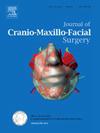A recurrence analysis in patients with congenital choanal atresia
IF 2.1
2区 医学
Q2 DENTISTRY, ORAL SURGERY & MEDICINE
引用次数: 0
Abstract
Recurrences following congenital choanal atresia (CA) repair are a particular challenge. This study sought to investigate the underlying causes of recurrences. The study compared 33 primary surgeries (controls, median age 32 months) to 34 revision surgeries (revision group, median age 10 months) performed between 2010 and 2024 at the department of otorhinolaryngology of a German university hospital. Demographic data, surgery time [min], length of hospitalization [nights] and the intraoperatively identified causes of recurrences were analysed. To test for differences between the two groups, the Mann-Whitney-U test was applied. The Chi-square test was used to test for correlations. In the revision group, 88 % (30/34) of the recurrences were attributable to insufficient vomer resections. An additional 12 % (4/34) were attributable to granulations. The revision group was more likely to have a bilateral choanal atresia (p < 0.001). Surgery time was equal in both groups (p = 0.115). Dominantly, insufficient posterior vomer resections, but also granulation tissue growth present the primary causes of recurrence. Adequate resection of the posterior vomer is essential for optimal outcomes and can be achieved with small effort. The implementation of this technique as standard procedure has the potential to reduce the risk of recurrence and enhance the care of patients with CA.
先天性后肛门闭锁复发分析。
先天性后肛门闭锁(CA)修复后的复发是一个特别的挑战。本研究旨在探讨复发的潜在原因。该研究比较了2010年至2024年间在德国大学医院耳鼻喉科进行的33例原发性手术(对照组,中位年龄32个月)和34例翻修手术(翻修组,中位年龄10个月)。对人口学资料、手术时间(min)、住院时间(nights)和术中确定的复发原因进行分析。为了检验两组之间的差异,采用了Mann-Whitney-U检验。采用卡方检验检验相关性。在翻修组中,88%(30/34)的复发是由于肿瘤切除不够。另有12%(4/34)可归因于颗粒。翻修组更有可能出现双侧后肛门闭锁(p
本文章由计算机程序翻译,如有差异,请以英文原文为准。
求助全文
约1分钟内获得全文
求助全文
来源期刊
CiteScore
5.20
自引率
22.60%
发文量
117
审稿时长
70 days
期刊介绍:
The Journal of Cranio-Maxillofacial Surgery publishes articles covering all aspects of surgery of the head, face and jaw. Specific topics covered recently have included:
• Distraction osteogenesis
• Synthetic bone substitutes
• Fibroblast growth factors
• Fetal wound healing
• Skull base surgery
• Computer-assisted surgery
• Vascularized bone grafts

 求助内容:
求助内容: 应助结果提醒方式:
应助结果提醒方式:


